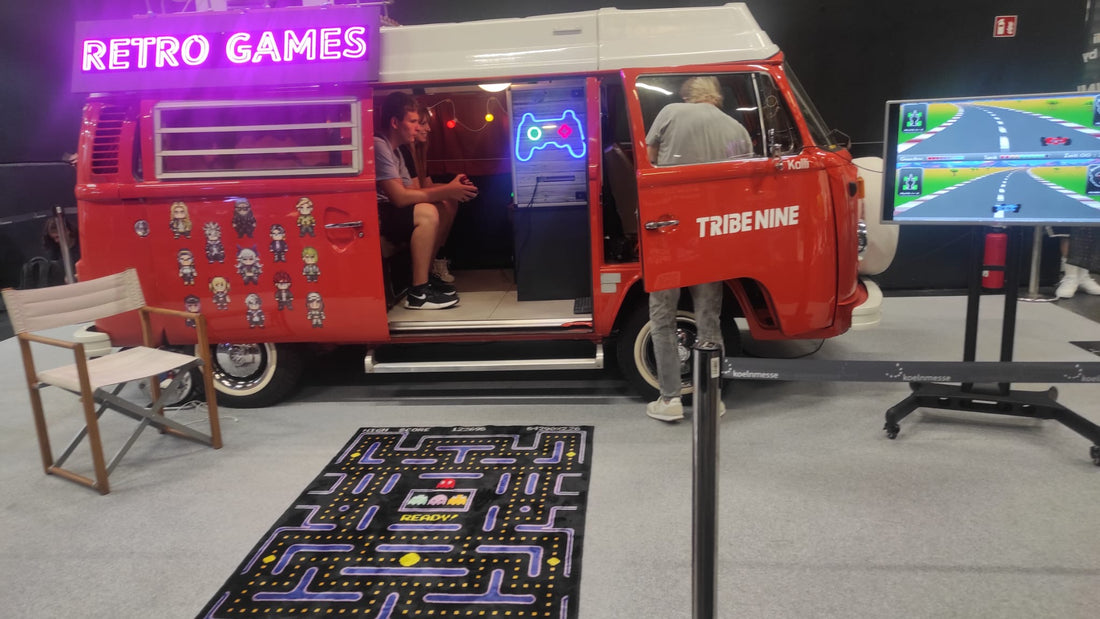
A publisher’s view: Retro Area on Gamescom 2024
Marco BreddinShare
Author René Meyer has been organising the sub-event for Gamescom since 2009 and this year was once again able to transform almost half of the hall into the age of microcomputers. For the first time, Microzeit was present at a joint stand with Look Behind You and Gameplan.

United Book Stand
The German retro book publishers gathered in Hall 10.2 and, with a few exceptions, focussed on 8- and 16-bit computers and consoles. Overall, Retro Area was opulently staffed and not short of big names and pixel legends.

Factor 5 in the Area
An absolute must for an ’80s kid in Germany is the Kaiko & Factor 5 stand, which, like a long spaceship in the centre of the area, attracted visitors with many different gameplay options for Apydia (II) and Turrican. A lovingly designed showcase of Rainbow Arts artefacts and Star Wars originals did the rest to be fascinated again. With Willi Bäcker, Andreas Escher, Lutz Osterkorn and Chris Hülsbeck, there was always plenty to talk about the industry and veterans such as Hans Ippisch met here to chat.

Retro Games on Replicas
One focus of the orange exhibition area was the implementation of old bit technology in current FPGA and Android derivatives with contemporary operation and modern interfaces. Manufacturers presented not only a whole armada of Nintendo and Sega consoles, but also the coveted Atari and Commodore systems from “THESeries”, which aim to transport nostalgic adults as well as children and young people back to the old pixel world with preload games. THEVIC20 and THE400 Mini last. But after “Mini” it has to be “Maxi” and so The Spectrum and THEA500 Maxi have already been announced.

When is “THEAtari ST” coming?
We also regretted that there was not enough luggage for an original ST to make our small publisher’s stand more lively and to give the audience more insights into the difficult to convey scene topic. All the more surprising were the crowds of visitors at the ABBUC (Atari Bit Byter User Club) stand, where every day two STs threw a small black pixel ball over patterned 640x400 mountains to crush the opposing kingdom.

Ballerburg, a little German Public Domain game from 1987, can still gather younger people around a monochrome Atari SM124 in the year 2024.
Playing or Browsing?
A special feature of our trade fair stand was certainly the combination of people and themes relating to home computers and consoles. Here, our publishing colleagues from Look Behind You not only succeeded in creating an attractive book presentation, but also in bringing the stand to life with an atmospheric illuminated display case and logos, large-scale pixel animations and small arcade tables. We at Microzeit added the Atari world to the solid portfolio of Monkey Island, Basic, Amiga OS and Commodore books. This gave visitors the choice not only to browse through an extensive retro programme, but also to play games on THEA500 Mini, burn up on a Vectrex or shine on the Atari 7800.

History & Future
Editors, tech and games journalists as well as marketing, software and hardware experts formed the staff at our joint stand. This was where Winnie Forster (Power Play, Retro Gamer) presented his extensive Gameplan encyclopaedias, Stefan Freundorfer (Man!ac, Retro Gamer) the extended German version of The Creation of Prince of Persia and David J. Pleasance (Commodore UK) the unique Commodore Inside and Amiga Vulture volumes including his hand signatures.
 Ready. Look Behind You after the stand was designed with great effort.
Ready. Look Behind You after the stand was designed with great effort.
 David John Pleasance signs one of our books for an enthusiastic reader.
David John Pleasance signs one of our books for an enthusiastic reader.
 Part of the ‘The Flame Wars’: Pleasance is always up for an eye-opening anecdote.
Part of the ‘The Flame Wars’: Pleasance is always up for an eye-opening anecdote.
 At trade fairs, you can have all books signed on request.
At trade fairs, you can have all books signed on request.
I was not only pleased to meet many old and new colleagues, I was also delighted by the many encounters with enthusiastic readers and interested questioners on the topics of 16-bit war, the scene, games and piracy. Our latest book ended up in the hands of its new owners so quickly that we were already sold out before the last day. During the fair, we took some spontaneous snapshots that we don’t want to withhold from you.


 Portrait photo series by Tatiana Bahamonde
Portrait photo series by Tatiana Bahamonde
Walk through the Retro Area
Our foray through the Retro Area took us past an Retr-O-Mat arcade machine, Amiga Hugo TV games, a well-attended C64 game park, the German Remix Group, Björn Baranski’s Männerquatsch Podcast, the obligatory Tetris competition as well as the eye-catching Dr Wuro Industries stand – with new C64 games that we can also find on the ST. In addition to other stands for the common joystick enthusiasts, the publishers around Return and Retro Gamer were among the most conspicuous exhibitors in the Retro Area. As is well known, the latter have only recently become independent and are currently offering an annual subscription at a one-off special price (retro-gamer.de). The interview rotation, moderated by editor-in-chief Jörg Langer, also featured gaming veterans such as Matthias Hengst (Power Play) and developer legends such as Volker Wertich (The Settlers).

Developed on the Amiga: The Hugo Show was an interactive ‘teleplay’ that could be accessed by telephone in Germany from 1994 to 1998.

Veteran journalist Michael Hengst (right) joking with Jörg Langer. Hengst was part of the first Power Play editorial team and responsible for most of the role-playing game tests.
Imperial stormtroopers appeared not far away for an uninhibited photo shoot with the audience, while the vast console landscape of Retrospiel offered uninhibited gamepad abuse. By the way, you will soon be able to view and buy Microzeit books at Christoph Noll’s shop in Cologne (www.retrospiel.com).

 Do you suffer from a Star Wars addiction? Then come to Gamescom and find out why.
Do you suffer from a Star Wars addiction? Then come to Gamescom and find out why.
The Retro Area is also a contact exchange for everyone involved. We have been able to make more interview contacts for the current book project 68000: Power Without The Price and are looking forward to exclusive content from German game developers. In addition to live music and Guitar Hero, the retro stage also invited visitors to listen to autobiographical talks. Chris Hülsbeck talked about his youth, his personal pioneering spirit and his musical journey. In addition, the Arizona-based chipsound specialist, who has now released 75 albums, gave unusual insights into the psyche of a developer.

 A look into the past: early C64/Amiga composer Chris Hülsbeck is still involved in a number of modern game music projects.
A look into the past: early C64/Amiga composer Chris Hülsbeck is still involved in a number of modern game music projects.
It rarely remained silent at the Gamescom and it was a challenge for everyone involved. Apart from Le Chuck and Giana, we hardly understood every cosplay figure appearing in front of our stand. From skull-splitting chainsaws to gigantic sword-bearers, from mechas to elite space units and male manga schoolgirls, everything and everyone was represented. It’s still fun to see a zombie rummaging through the publishing programme. However, the little spring buds on the heads of many visitors seemed more relaxed to us.

Coming up this Winter: X-Out Resurfaced for the Nintendo Switch from ININ Games. The little-known underwater shooter by Rainbow Arts now offers modern gameplay and graphics.
Retro Games are not a trend
The redesign of 16-bit classics from our youth is extremely pleasing. Retro has long since ceased to be a trend. The Indie Area brought together no fewer than 130 new releases – a significant proportion with a refreshing pixel look.
Just as vinyl has reclaimed a cultural and economic place in music playback, mobile entertainment concepts have increasingly revitalised the old pixel style and are now even inspiring new games on old machines.
We from Microzeit see the familiar atmosphere and reference to an outstanding period in the gaming industry as the greatness of the orange area, which has historically been full of competition and conflict. Some young people have come up to me to explain their connection to Retro as follows: “The battle continues on the modern consoles”.


